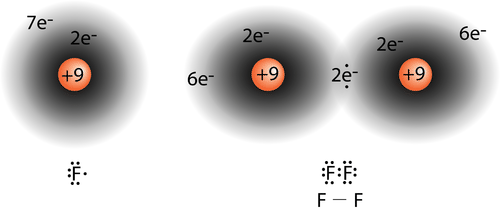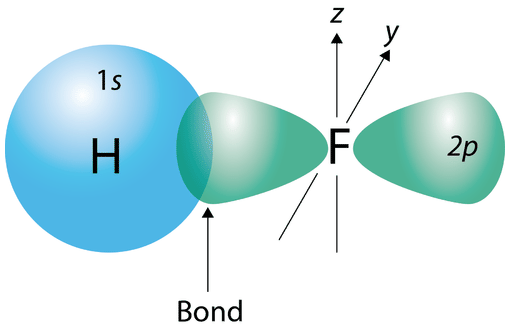19.12: Valence Bond Theory
( \newcommand{\kernel}{\mathrm{null}\,}\)
 Figure 19.12.1 (CC BY-NC 3.0; Jodi So via CK-12 Foundation)
Figure 19.12.1 (CC BY-NC 3.0; Jodi So via CK-12 Foundation)
What happens next?
We have seen that the old fish-hook idea of atoms connecting that Democritus liked so much just doesn’t work. Electrons don’t have little hooks on them, but they are the basis for connecting atoms to form molecules. You have learned how to write Lewis electron-dot structures for molecules and predict their shape using VSEPR theory. Now it is time to apply these abilities to understand how the electrons behave in their atomic orbitals when a covalent bond forms.
Valence Bond Theory
You have learned that a covalent bond forms when the electron clouds of two atoms overlap one another. In a simple H2 molecule, the single electron in each atom becomes attracted to the nucleus of the other atom in the molecule as the atoms come closer together. An optimum distance, equal to the bond length, is eventually attained, and the potential energy reaches a minimum. A stable, single covalent bond has formed between the two hydrogen atoms. Other covalent bonds form in the same way as unpaired electrons, when two atoms "match up" to form the bond. In a fluorine atom, there is an unpaired electron in one of the 2p orbitals. When a F2 molecule forms, the 2p orbitals from each of the two atoms overlap to produce the F−F covalent bond. The overlapping orbitals do not have to be of the same type. In a molecule of HF, the 1s orbital of the hydrogen atom overlaps with the 2p orbital of the 2p orbital of the fluorine atom (see figure below).
 Figure 19.12.2: A molecule of hydrogen fluoride (HF). (CC BY-NC 3.0; Jodi So via CK-12 Foundation)
Figure 19.12.2: A molecule of hydrogen fluoride (HF). (CC BY-NC 3.0; Jodi So via CK-12 Foundation)
In essence, any covalent bond results from the overlap of atomic orbitals. This idea forms the basis for a quantum mechanical theory called valence bond (VB) theory. In valence bond theory, the electrons in a molecule are assumed to occupy atomic orbitals of the individual atoms, and a bond results from overlap of those orbitals.
Summary
- Electrons occupy atomic orbitals.
- Covalent bonds result from the overlap of atomic orbitals.
Review
- Where are electrons according to valence bond theory?
- How do covalent bonds form?
- Do the orbitals of the two electrons involved in the bond need to be the same?


